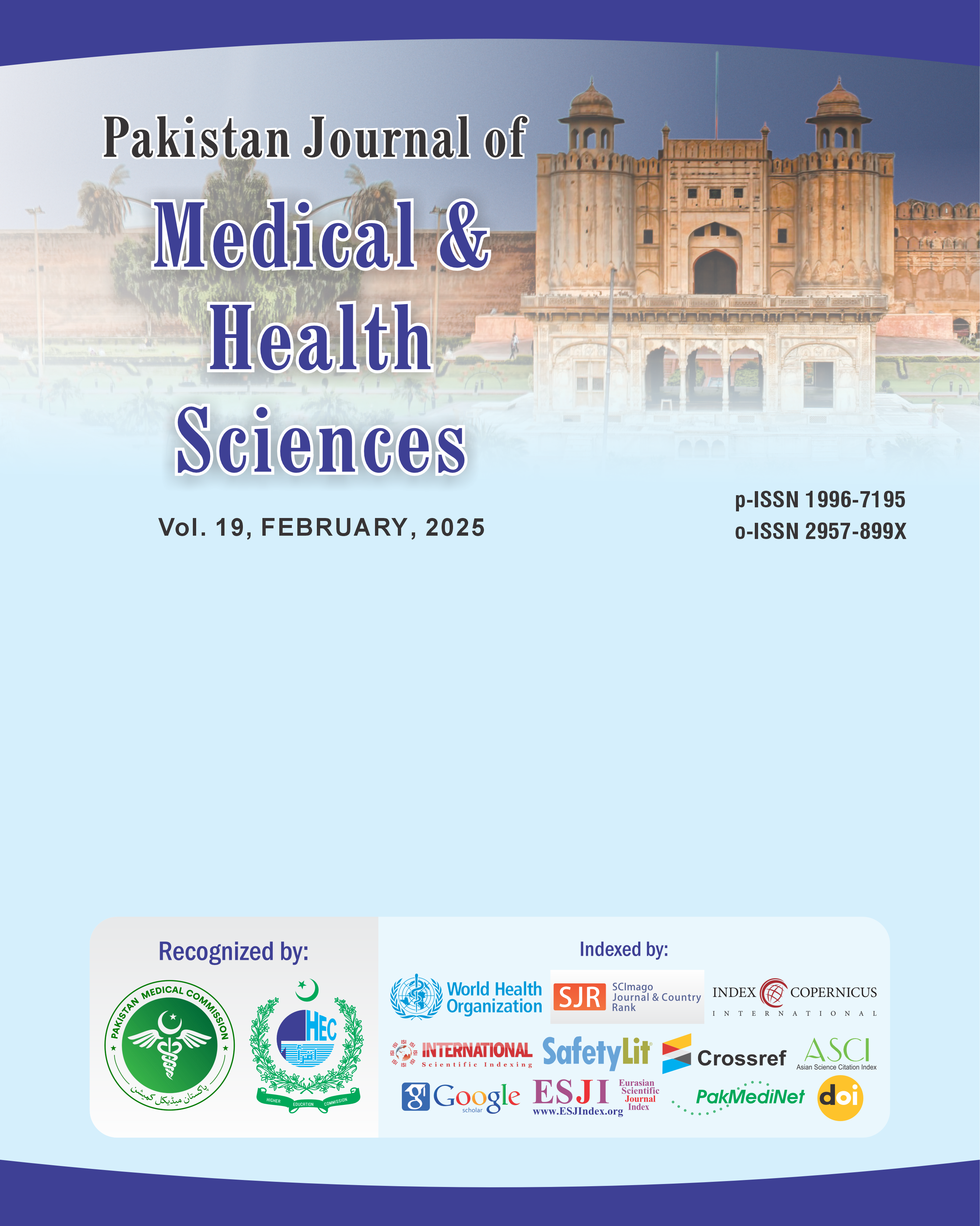Evaluation of Outcomes in Patients Undergoing Surgery for Brain Tumors A Prospective Clinical Study
DOI:
https://doi.org/10.53350/pjmhs02025192.4Keywords:
Postoperative, Benign Tumor Cases, Malignant Cases, Glioblastoma Multiform, PostoperativelyAbstract
Background: Local data are still needed to optimize surgical practices, despite surgical resection being the first line of treatment for many brain tumors, as outcome variability dictates.
Aim: To evaluate postoperative outcomes including neurological function, survival and quality of life in a cohort of 25 patients undergoing brain tumor surgery in a tertiary center.
Methodology: It was a prospective observational study of 25 adult patients who underwent elective craniotomy for brain tumor removal during 6 months. Clinical presentation, imaging, histopathology, extent of resection, complications and 3 month functional outcomes were collected.
Results: Fifteen patients were male and 10 female (mean age: 47.6 ± 11.2 years, out of 25 patients). The most common tumor types were meningioma (9 cases) and glioblastoma multiform (7 cases). Patients achieved gross total resection (GTR) in 64%. Sixty percent improved, 24 percent were stable, and 20 percent deteriorated postoperatively. In benign tumor cases, three month survival was 100%, and in malignant cases, the survival was 71.4%. Complications occurred in 4 patients (16%).
Conclusion: Postoperatively, this cohort showed significant improvement in neurological function in benign tumors. Repetition of the need for surgical precision and early intervention is supported by the finding that extent of resection remains a critical determinant of outcome.
References
Bhat AR, Wani MA, Kirmani AR (2022) Infra-tentorial brain tumor subtypes in children and adults—surgical outcome in an ethnic population with a single regional tertiary center. Chin Neurosurg J 8(1):1–9
Dao Trong P, Olivares A, El Damaty A, Unterberg A (2023) Adverse events in neurosurgery: a comprehensive single-center analysis of a prospectively compiled database. ActaNeurochir (Wien) 165(3):585–593
Dasenbrock HH, Yan SC, Smith TR, Valdes PA, Gormley WB, Claus EB, Dunn IF (2017) Readmission after craniotomy for tumor: a national surgical quality improvement program analysis. Neurosurgery 80(4):551–562
De la Garza-Ramos R, Kerezoudis P, Tamargo RJ, Brem H, Huang J, Bydon M (2016) Surgical complications following malignant brain tumor surgery: an analysis of 2002–2011 data. ClinNeurolNeurosurg 140:6–10
Delgado-Fernandez J, Garcia-Pallero MÁ, Blasco G, Penanes JR, Gil-Simoes R, Pulido P, Sola RG (2017) Usefulness of reintervention in recurrent glioblastoma: an indispensable weapon for increasing survival. World Neurosurg 108:610–617
Dimick JB, Chen SL, Taheri PA, Henderson WG, Khuri SF, Campbell DA (2004) Hospital costs associated with surgical complications: a report from the private-sector National Surgical Quality Improvement Program. J Am CollSurg 199(4):531–537
Dindo D, Demartines N, Clavien P-A (2004) Classification of surgical complications: a new proposal with evaluation in a cohort of 6336 patients and results of a survey. Ann Surg 240(2):205–213
Dindo D, Demartines N, Clavien P-A (2004) Classification of surgical complications. Ann Surg 240(2):205–213
Donoho DA, Wen T, Babadjouni RM, Schwartzman W, Buchanan IA, Cen SY, Zada G, Mack WJ, Attenello FJ (2018) Predictors of 30- and 90-day readmission following craniotomy for malignant brain tumors: analysis of nationwide data. J Neurooncol 136(1):87–94
Duclos A, Chollet F, Pascal L, Ormando H, Carty MJ, Polazzi S, Lifante J-C (2020) Effect of monitoring surgical outcomes using control charts to reduce major adverse events in patients: cluster randomised trial. BMJ 371:m3840
Eisenring CV, Neidert MC, Bové DS, Held L, Sarnthein J, Krayenbühl N (2013) Reduction of thromboembolic events in meningioma surgery: a cohort study of 724 consecutive patients. PLoS One 8(11):e79170
Florman JE, Cushing D, Keller LA, Rughani AI (2017) A protocol for postoperative admission of elective craniotomy patients to a non-ICU or step-down setting. J Neurosurg 127(6):1392–1397
Giesbrecht V, Au S (2016) Morbidity and mortality conferences: a narrative review of strategies to prioritize quality improvement. JT Comm J Qual Patient Saf 42(11):516–527
GómezVecchio T, Corell A, Buvarp D, Rydén I, Smits A, Jakola AS (2021) Classification of adverse events following surgery in patients with diffuse lower-grade gliomas. Front Oncol 11
Grundy PL, Weidmann C, Bernstein M (2008) Day-case neurosurgery for brain tumours: the early United Kingdom experience. Br J Neurosurg 22(3):360–367
Houkin K, Baba T, Minamida Y, Nonaka T, Koyanagi I, Iiboshi S (2009) Quantitative analysis of adverse events in neurosurgery. Neurosurgery 65(3):587
Ivanovic J, Seely AJE, Anstee C, Villeneuve PJ, Gilbert S, Maziak DE, Shamji FM, Forster AJ, Sundaresan RS (2014) Measuring surgical quality: comparison of postoperative adverse events with the American College of Surgeons NSQIP and the Thoracic Morbidity and Mortality classification system. J Am CollSurg 218(5):1024–1031
18.Jenkins FS, Vasella F, Padevit L, Mutschler V, Akeret K, Velz J, Regli L, Sarnthein J, Neidert MC (2021) Preoperative risk factors associated with new focal neurological deficit and other major adverse events in first-time intracranial meningioma neurosurgery. ActaNeurochir (Wien) 163(10):2871–2879
Kashiwazaki D, Saito H, Uchino H, Akioka N, Hori E, Shibata T, Tomita T, Akai T, Kuwayama N, Kuroda S (2020) Morbidity and mortality conference can reduce avoidable morbidity in neurosurgery: its educational effect on residents and surgical safety outcomes. World Neurosurg 133:e348–e355
LandrielIbañez FA, Hem S, Ajler P, Vecchi E, Ciraolo C, Baccanelli M, Tramontano R, Knezevich F, Carrizo A (2011) A new classification of complications in neurosurgery. World Neurosurg 75(5–6):709–715 (discussion 604-611)
Downloads
How to Cite
Issue
Section
License
Copyright (c) 2025 SAUD AHMED, MUHAMAAD NAEEM UR REHMAN, HASSAAN SHARIF

This work is licensed under a Creative Commons Attribution 4.0 International License.


